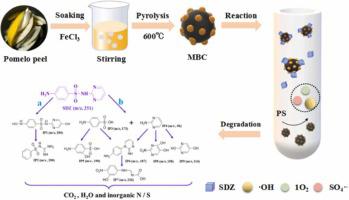Process Safety and Environmental Protection ( IF 7.8 ) Pub Date : 2021-11-25 , DOI: 10.1016/j.psep.2021.11.045 Fu-Xin Dong 1 , Liu Yan 1 , Shi-Ting Huang 1 , Jing-Yi Liang 1 , Wen-Xuan Zhang 1 , Xiao-Wen Yao 1 , Xie Chen 1 , Wei Qian 1 , Peng-Ran Guo 2 , Ling-Jun Kong 3 , Wei Chu 4 , Zeng-Hui Diao 1

|
Nowadays, the harm of antibiotics residues in environments to human health and ecological safety has been causing more and more attention. In this paper, a biochar based iron material (MBC) was used to activate persulfate (PS) for the removal of sulfadiazine (SDZ) from aqueous solution. Experiment results indicate that the degradation and mineralization of SDZ by MBC/PS system reached 91.79% and 60% within 60 min under the optimal reaction conditions, respectively. MBC/PS system exhibited a better performance on SDZ removal compared with MBC/H2O2 system. The addition of Cu2+ ion could enhance the degradation of SDZ by MBC/PS system. PO43-, Cl- and SO42- had a certain degree of inhibitory effect on the SDZ degradation. Both radicals and non-radical species such as SO4•-, •OH and 1O2 participated in the degradation reaction of SDZ by MBC/PS system, but •OH was the main radical species responsible for SDZ degradation. The liquid chromatograph-mass spectrometer (LC-MS) technique was used to identify the intermediate products of SDZ, and it was proposed that the degradation of SDZ might be achieved through hydrolyzation, hydroxylation, deamination and amino-oxidization processes. A possible reaction mechanism involving a synergistic effect between PS homogeneous and heterogeneous activation processes as well as both radicals and non-radicals reactions was finally proposed.
中文翻译:

生物炭基材料活化过硫酸盐氧化系统去除抗生素磺胺嘧啶:性能、产品和机制
如今,环境中抗生素残留对人类健康和生态安全的危害越来越引起人们的关注。在本文中,生物炭基铁材料 (MBC) 用于活化过硫酸盐 (PS),以去除水溶液中的磺胺嘧啶 (SDZ)。实验结果表明,在最佳反应条件下,MBC/PS体系对SDZ的降解和矿化在60 min内分别达到91.79%和60%。与MBC/H 2 O 2系统相比,MBC/PS 系统在SDZ 去除方面表现出更好的性能。Cu 2+离子的加入可以增强MBC/PS体系对SDZ的降解。PO 4 3-、Cl -和 SO 4 2-对SDZ降解有一定的抑制作用。自由基和非自由基物种如SO 4 •-、•OH和1O 2 都参与了MBC/PS体系对SDZ的降解反应,但•OH是负责SDZ降解的主要自由基物种。采用液相色谱-质谱联用技术对SDZ的中间产物进行鉴定,提出SDZ的降解可能通过水解、羟基化、脱氨基和氨基氧化等过程实现。最后提出了一种可能的反应机制,涉及 PS 均相和非均相活化过程以及自由基和非自由基反应之间的协同作用。



























 京公网安备 11010802027423号
京公网安备 11010802027423号